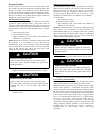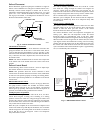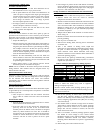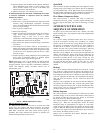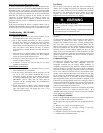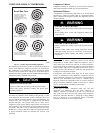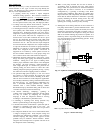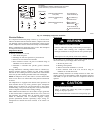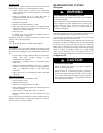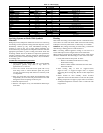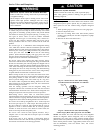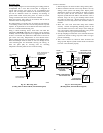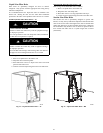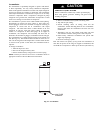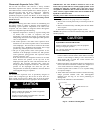
22
Ground
Circuit
To determine if a wire has broken or come in direct contact with
shell, causing a direct short to ground, follow these steps:
1. Allow crankcase heaters to remain on for several hours
before checking motor to ensure windings are not saturated
with refrigerant.
2. Using an ohmmeter on R X 10,000 ohm scale or
megohmmeter (follow manufacturer’s instructions).
3. Be sure all power is off.
4. Discharge all capacitors.
5. Remove wires from terminals C, S, and R.
6. Place one meter probe on ground or on compressor shell.
Make a good metal--to--metal contact. Place other probe on
terminals C, S, and R in sequence.
7. Note meter scale.
8. If reading of 0 or low resistance is obtained, motor is
grounded. Replace compressor.
Compressor resistance to ground should not be less than 1000
ohms per volt of operating voltage.
Example:
230 volts X 1000 ohms/volt = 230,000 ohms minimum.
Short
Circuit
To determine if any wires within windings have broken through
their insulation and made contact with other wires, thereby shorting
all or part of the winding(s), be sure the following conditions are
met.
1. Correct motor winding resistances must be known before
testing, either from previous readings or from
manufacturer’s specifications.
2. Temperature of windings must be as specified, usually
about 70_F.
3. Resistance measuring instrument must have an accuracy
within ± 5--10 percent. This requires an accurate ohmmeter
such as a Wheatstone bridge or null balance--type
instrument.
4. Motor must be dry or free from direct contact with liquid
refrigerant.
Make This Critical
Test
(Not advisable unless above conditions are met)
1. Be sure all power is off.
2. Discharge all capacitors.
3. Remove wires from terminals C, S, and R.
4. Place instrument probes together and determine probe and
lead wire resistance.
5. Check resistance readings from C--R, C--S, and R--S.
6. Subtract instrument probe and lead resistance from each
reading.
If any reading is within ±20 percent of known resistance, motor is
probably normal. Usually a considerable difference in reading is
noted if a turn--to--turn short is present.
REFRIGERATION SYSTEM
Refrigerant
UNIT OPERATION AND SAFETY HAZARD
Failure to follow this warning could result in personal injury
or equipment damage.
Puronr refrigerant which has higher pressures than R--22 and
other refrigerants. No other refrigerant may be used in this
system. Gauge set, hoses, and recovery system must be
designed to handle Puronr. If you are unsure consult the
equipment manufacturer.
!
WARNING
In an air conditioning and heat pump system, refrigerant transfers
heat from one replace to another. The condenser is the outdoor coil
in the cooling mode and the evaporator is the indoor coil.
In a heat pump, the condenser is the indoor coil in the heating
mode and the evaporator is the outdoor coil.
In the typical air conditioning mode, compressed hot gas leaves the
compressor and enters the condensing coil. As gas passes through
the condenser coil, it rejects heat and condenses into liquid. The
liquid leaves condensing unit through liquid line and enters
metering device at evaporator coil. As it passes through metering
device, it becomes a gas--liquid mixture. As it passes through
indoor coil, it absorbs heat and the refrigerant moves to the
compressor and is again compressed to hot gas, and cycle repeats.
Compressor Oil
UNIT DAMAGE HAZARD
Failure to follow this caution may result in equipment
damage or improper operation.
The compressor in a Puronr system uses a polyol ester
(POE) oil. This oil is extremely hygroscopic, meaning it
absorbs water readily. POE oils can absorb 15 times as much
water as other oils designed for HCFC and CFC refrigerants.
Take all necessary precautions to avoid exposure of the oil to
the atmosphere. (See Table 4.)
CAUTION
!



